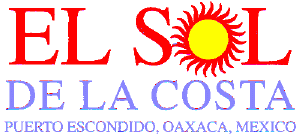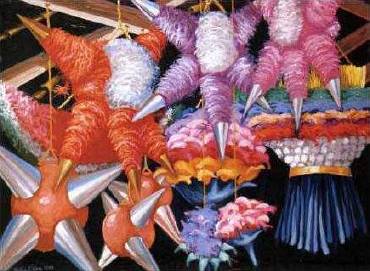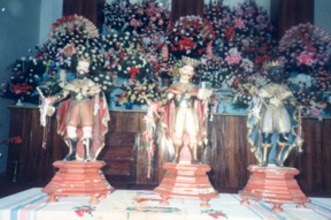

They begin with a candle-lit procession led by a couple dressed as the holy duo. Singing the traditional Posada hymn, the participants stop at two homes in the neighborhood and ask for shelter, but are turned away. The third stop is the location of the Posada, where the couple are warmly admitted..
Most important to the Christmas celebration is Noche Buena, ("Good Night"), Christmas Eve. This is when families traditionally gather for their Christmas feast and perhaps later attend the Misa del Gallo, midnight mass.
Besides tamales, an essential for any Oaxacan celebration. Other traditional seasonal dishes include bacalao (dried fish), bunuelos (sweet fritters), the delicious hominy soup known as pozole, atole (a corn gruel drink), horchata (the same made with rice), ponches (fruit punches) and a kind of rice pudding known as Arroz a la Mexicana.
Christmas Day (Navidad) is an unearthly quiet Mexican day, as the families sleep and recover after all-night festivities. The traditional day for gift giving is Epiphany or Day of the Kings on January 6.
 Although the Piñata originated in China, the traditional party favorite
of Mexican children travelled along the trade routes to Italy where it
was named pigata or pineapple in Italian, then to Spain in time to be
taken to the new world by the missionaries.
Although the Piñata originated in China, the traditional party favorite
of Mexican children travelled along the trade routes to Italy where it
was named pigata or pineapple in Italian, then to Spain in time to be
taken to the new world by the missionaries.
The serious symbolism of this simple party toy is very typical of México, as there is always more to understand than appears on the surface. The decorated clay pot represents Satan who often wears an attractive mask to hide his true nature. The most traditional style of Piñata is a star with seven points with streamers. These cones represent the seven deadly sins, and the breaking of the Piñata with the ensuing shower of sweets and fruits and nuts vividly shows the triumph of good over evil and the unknown joys and rewards which will be given in heaven to the good and faithful.
 One of the familiar symbols of the season you will find in México is
the Poinsetta, know here as Noche Buena (Good Night, meaning Christmas
Eve), Flor de Niluyarili in Chiapas and Hoja de Flor in Central America.
One of the familiar symbols of the season you will find in México is
the Poinsetta, know here as Noche Buena (Good Night, meaning Christmas
Eve), Flor de Niluyarili in Chiapas and Hoja de Flor in Central America.
The plant was the obsession of Dr. Joel Poinsett, the first ambassador of the United States to México, who gave it his name and introduced it to the rest of the world
The ancients, who considered all flowers to be divine gifts of the Gods, knew this plant as Cuetlaxochitl, which means "the flower of leather petals". This star-shaped, red, winter-flowering plant was a special favorite long before the arrival of Columbus. The Nochebuena was considered by the Aztecs to be a symbol of the new life earned by the warriors who died in battle . As hummingbirds and butterflies, they returned to earth to sip the nectar of the Poinsettia.
 The 12th Night of Christmas, Epiphany or Day the Kings, is the
traditional day for Christmas gift giving in México., You don't really
believe in Santa, do you? It was the three kings, or Magi; Gaspar,
Melchior and Balthazar who brought the gifts to the baby Jesus. There
will be parties with piñatas, sweets and toys for the kids. National
and local Toy Drives help bring a smile today to the faces of some of
the neediest youngsters.
The 12th Night of Christmas, Epiphany or Day the Kings, is the
traditional day for Christmas gift giving in México., You don't really
believe in Santa, do you? It was the three kings, or Magi; Gaspar,
Melchior and Balthazar who brought the gifts to the baby Jesus. There
will be parties with piñatas, sweets and toys for the kids. National
and local Toy Drives help bring a smile today to the faces of some of
the neediest youngsters.
But the Christmas celebrations aren't quite over yet; one of the traditions of day is the sharing of the Rosca de Reyes, a rich, sweet egg bread that contains a small plastic doll. According to the custom, whomever receives the piece of bread containing the doll must host a party on Candlemas (La Candelaria) on Feb. 2.